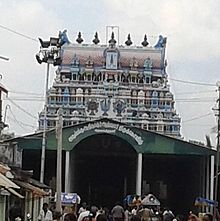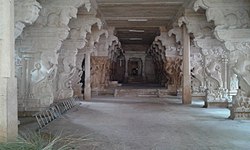Alwarthirunagari Permual Temple
| Alwarthirunagari Permual Temple | |
|---|---|
 Alwarthirunagari Permual Temple | |
| Religion | |
| Affiliation | Hinduism |
| District | Thoothukudi |
| Deity | Adinathar (Vishnu), Adinathavalli (Lakshmi) |
| Features |
|
| Location | |
| Location | Alwarthirunagiri |
| State | Tamil Nadu |
| Country | India |
| Geographic coordinates | 8°36′25.6″N77°56′17.9″E/ 8.607111°N 77.938306°E |
| Architecture | |
| Type | Dravidian architecture |
| Elevation | 44 m (144 ft) |
Alwarthirunagari Permual Templeis aHindu temple,dedicated toVishnuandLakshmiinAlwarthirunagari,a town inThoothukudi districtin the Indian state ofTamil Nadu.
It is located 26 km fromTirunelveli.Constructed in theDravidian style of architecture,the temple is glorified in theNaalayira Divya Prabandham,the early medievalTamilcanon of theAlwarsaints from the 6th–9th centuries CE. It is one of the 108Divya Desamsdedicated to Vishnu, who is worshipped as Adinathar and Lakshmi, who is worshipped as Adinathavalli.[1]The temple is also classified as aNavatirupati,the nine temples revered byNammalvarlocated in the banks ofThamirabaraniriver. The temple is the most prominent among the nineNavatirupatitemples. The temple is one of the Navagraha temples inVaishnavism,associated withBrihaspati.
A granite wall surrounds the temple, enclosing all its shrines and two of its three bodies of water. Therajagopuram,the temple's gateway tower, is 95 ft (29 m) tall. The temple is considered the birthplace ofNammalvar,considered the most prominent among the twelve Alvars Saints. The temple followsTenkalaitradition of worship. Six daily rituals and three yearly festivals are held at the temple, of which the ten-day annual Brahmotsavam during theTamilmonth ofChittirai(April - May) and the Nammalvar birth celebrations with Garudasevai with all nine temple of Navatirupathi, being the most prominent. The temple is maintained and administered by the Hindu Religious and Endowment Board of theGovernment of Tamil Nadu.
Legend[edit]

Alwartirunagari is believed to be the largest town in the time ofPandyakings and queens. The distinguishing name, withAlwarinTamilprefixed to Thirunagari means the people who spoke languages first and speaks correct language.[2]The temple is considered the birthplace ofNammalvar,considered the most prominent among the twelveAlwarsSaints. Nammalvar has contributed more than thousand verses out of the four thousand inNaalayira Divya Prabhandam,theVaishnavacanon.[3]
According to traditional scriptures, Nammalvar was born in 43rd Kali of 3059 BCE.[4]He was born in a Mallar family at Thirukuravur (modern dayAlwarthirunagiri) in the southernmost region of theTamil Nadu.[5][6]According to legend, as a child, he responded to no external stimuli and his parents left him at the feet of Adhinathar and Adinathavalli of Nagar tribe inAlwarthirunagari.The child then got up and climbed into a hole in atamarindtree, sat in thelotus position,and began to meditate. It appears he was in this state for as long as sixteen years when aTamilpoet and scholar in Madurai namedMadhurakavi Alwarsaw a bright light shining in the south, and followed it until he reached the tree where the boy was residing. Unable to elicit any reaction from the child, he asked him a riddle: "If the small one is born in a dead's body, what will it eat and where will it stay?" meaning, if the subtle soul is embodied in the gross body, what are its actions and thoughts? Nammalvar broke his lifelong silence and responded, "That it will eat, it will rest!" meaning that if the soul identifies with the body, it will be the body but if it serves the divine, it will stay inVaikunthaand eat (think) of Vishnu and Lakshmi.[7]Madhurakavi Alwarrealized the divinity of this child and became a devotee of the child. The works of Nammalvar were compiled by Madhurakavi Alwar as four different works, theTiruvaymoli(1102 verses),Tiruviruttam(100 verses),Tiruvaciriyam(7 verses) andPeriya Tiruvantati(87 verses). The works of Nammalvar contributed to the philosophical and theological ideas of Vaishnavism. Along with the three Samaya Kuravargal, theShaivaNayanarsAppar,Sundarar,Sambandar,they influenced the dominant rulingPallavakings and queens, changing the religious geography fromBuddhismandJainismtoHinduism.[8][9][10]
Architecture[edit]
A granite wall surrounds the temple, enclosing all its shrines and two of its three bodies of water. Therajagopuram,the temple's gateway tower, is 95 ft (29 m) tall. Vishnu is worshipped here as Adinathar. TheSvayambhumurtisof Vishnu and Lakshmi face east and is in the standing posture. The feet of these two murtis are buried under earth. Vishnu is worshipped as Adinathar and Lakshmi is worshipped as Adinathavalli here. The shrine is located on the banks of Thamiraparani River. Thesacred water bodyin the temple is known asBrahmaTirtha.In modern times, the temple is maintained and administered by the Hindu Religious and Endowment Board of theGovernment of Tamil Nadu.[11]The temples houses a number of paintings depicting various scenes of the epicRamayana.There are composite pillars in the temple numbering 48 which has remarkable sculptures. There is a tamarind tree on the precincts of the temple, which is believed to have been the birth place of Nammalvar. Devotees take strips of the trees for medicinal purposes.[12]
Religious significance[edit]

According to theBrahmanda Purana,one of the eighteen sacredPuranasof Hinduism and written byVyasacontains a chapter called Navatirupati Mahatmyam. The second part of the chapter refers to Alwarthirunagari.[13]The temple is revered inNalayira Divya Prabandham,the 7th–9th century CE Vaishnava canon, byNammalvar.The temple is classified as aDivya Desam,one of the 108 Vishnu temples that are mentioned in the book. The temple is also classified as aNavatirupati,the nine temples revered by Nammalvar located in the banks ofThamirabaraniriver. The temple is the most prominent among the nineNavatirupatitemple.[13][14]Nammalvar makes a reference about the temple in his works inTiruvaymoli.During the 18th and 19th centuries CE, the temple finds mention in several works like108 Tirupati Antatiby Divya Kavi Pillai Perumal Ayangar. The temple also forms a series of Navagraha temples where each of the nine planetary gods of one of the temples of Navatirupati. The temple is associated withBrihaspati.[15][16][17]
Festival and religious practices[edit]

TheGarudasevai utsavam(festival) in the month of Vaikasi (May-June) witnesses nineGarudasevais,a spectacular event in which festival image idols of Vishnu and Lakshmi from the nine Nava Tirupatis shrines in the area are brought onGarudavahanaof Vishnu and Lakshmi. An idol of Nammalvar is also brought here on anAnna vahana(palanquin) and hispasurams(verses) dedicated to each of these nine temples are recited. Theutsavar(festival deity) of Nammalvar is taken in a palanquin to each of the nine temples, through the paddy fields in the area. Thepasurams(hymns) dedicated to each of the nineDivya Desamsare chanted in the respective shrines. This is the most important of the festivals in this area, and it draws thousands of visitors.
The temple follows the traditions of theTenkalaisect of Vaishnavite tradition and followsPancharatraagamas.The temple priest perform thepuja(rituals) during festivals and on a daily basis. As at other Vishnu and Lakshmi temples ofTamil Nadu,the priests belong to the TamilBrahmanaVaishnavaitecommunity.The temple rituals are performed four times a day:Kalasanthiat 8:00 a.m.,Uchikalamat 12:00 p.m.,Sayarakshaiat 6:00 p.m., andArdha Jamamat 8:00 p.m. Each ritual has three steps:alangaram(decoration),neivethanam(food offering) anddipa aradanai(waving of lamps) for both Adinathar and Adinathavalli. During the last step of worship,nadasvaram(pipe instrument) andthavil(percussion instrument) are played, religious instructions in theVedas(sacred text) are recited by priests, and worshippers prostrate themselves in front of the temple mast. There are weekly, monthly and fortnightly rituals performed in the temple.[14]
Notes[edit]
- ^M. S., Ramesh (1993).108 Vaishnavite Divya Desams: Divya desams in Pandya Nadu.Tirumalai-Tirupati Devasthanam..
- ^Annual report of the Archaeological Department, Southern Circle, Madras.By Archaeological Survey of India.
- ^V., Meena.Temples in South India.Kanniyakumari: Harikumar Arts. pp. 6–7.
- ^M. Srinivasachariar (1974).History of Classical Sanskrit Literature: Being an Elaborate Account of All Branches of Classical Literature, with Full Epigraphical and Archaeological Notes and References, an Introduction Dealing with Language, Philology, and Chronology, and Index of Authors & Works.Motilal Banarsidass Publisher. pp. 278–.ISBN978-81-208-0284-1.
- ^Sadarangani, Neeti M. (2004).Bhakti Poetry in Medieval India: Its Inception, Cultural Encounter and Impact.Sarup & Sons. p. 28.ISBN9788176254366.
- ^Carman, John B. (1994).Majesty and Meekness: A Comparative Study of Contrast and Harmony in the Concept of God.Wm. B. Eerdmans Publishing. pp. 64–65.ISBN9780802806932.
- ^Swami, Parmeshwaranand (2001).Encyclopaedic Dictionary of Purāṇas.Sarup & Sons. p. 908.ISBN9788176252263.
- ^B.S.2011, pp. 47-48
- ^Mukherjee (1999).A Dictionary of Indian Literatures: Beginnings-1850 Volume 1 of A Dictionary of Indian Literature, A Dictionary of Indian Literature.Orient Blackswan. p. 15.ISBN9788125014539.
- ^Garg, Gaṅgā Rām (1992).Encyclopaedia of the Hindu World: Ak-Aq.Concept Publishing Company. pp. 352–354.ISBN9788170223757.
- ^"Thirukoil - Temple list of Tamil Nadu"(PDF).Hindu Religious & Charitable Endowments Department, Government of Tamil Nadu. p. 244. Archived fromthe original(PDF)on 9 October 2020.Retrieved9 October2021.
- ^Pillai, S. Subramania (2019).Tourism in Tamil Nadu: Growth and Development.MJP Publisher. p. 16.ISBN978-81-8094-432-1.
- ^abM., Rajagopalan (1993).15 Vaishnava Temples of Tamil Nadu.Chennai, India: Govindaswamy Printers. pp. 155–159.
- ^ab"Sri Aadinaathan temple".Dinamalar. 2014.Retrieved31 May2014.
- ^"Amazing posture at Srivaikuntam".The Hindu.15 November 2001. Archived fromthe originalon 29 January 2003.Retrieved25 October2015.
- ^Suriya (2015).Jothirlingam: The Indian Temple Guide.Partridge Publishing. p. 30.ISBN9781482847864.
- ^Anantharaman, Ambujam (2006).Temples of South India.East West Books (Madras). pp. 33–43.ISBN978-81-88661-42-8.
References[edit]
- B. S., Chandrababu; S., Ganeshram; C., Bhavani (2011).History of People and Their Environs.Bharathi Puthakalayam.ISBN9789380325910.

